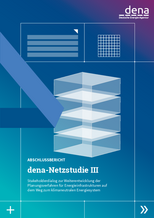
Cyberattack on dena: Find out more.
This was the challenge:
Our energy grids for electricity, gas, hydrogen and, on a local level, for heat bring energy supply and demand together. They are a crucial element for a functioning, sustainable energy system. In order to be able to cope with new transport tasks in the future climate-neutral energy system, the grids must be expanded and developed. The planning for the further development of the transport grids has been carried out since 2012 in the processes of the “Grid Development Plans” for electricity and gas. Due to the increasing coupling of the sectors and the move away from fossil fuels, however, planning the different grids in independent processes is no longer feasible. Because an adequate grid for electricity, gas, and hydrogen can only be planned if the development needs are coordinated in such a way that future transport tasks can be efficiently fulfilled. The main questions answered in the dena Grid Study III are how planning can be placed on a common basis and geared towards climate neutrality and how all stakeholders and civil society can be involved in the process at an early stage.
Our solution:
In close cooperation with representatives from politics, business, science and society, dena examined how the planning of the energy infrastructure can be optimised in terms of an integrated energy transition. The core result of this dialogue was the recommendation to introduce a system development plan (SDP), which precedes today's processes and places them on a common basis. Such a system development plan should not only help to determine common anchor points for further planning, but can also ensure greater transparency and participation in grid planning through the creation of a participatory process, thereby simplifying the subsequent planning steps. A SEP-process also provides a system development strategy that shows how the overall system can evolve efficiently while considering future infrastructure needs.
The effect:
The insights gained in the stakeholder group of the dena Grid Study III on how integrated planning of our energy infrastructure can be successful have provided important impetus for the further development of the current processes.
The central results of the exchange are summarized in the final report of the dena Grid Study III. It shows
